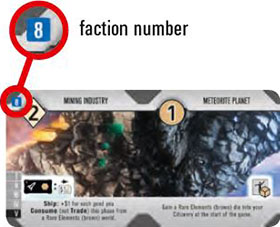
Roll for the Galaxy is a dice game of building space empires. Your dice represent workers who develop new technologies, settle worlds, and ship goods. The player who best manages his workers and builds the most prosperous empire wins!
Components

- 5 dice cups
- 5 credit markers
- 5 player mats
- 5 player screens
- 5 phase strips
- 9 faction tiles
- 9 home world tiles
- 111 custom dice
- 55 game tiles
- 1 cloth bag
- 33 victory point (VP) chips
- 5 phase tiles
- rulebook
Object of the Game
In Roll for the Galaxy, each player creates a galactic civilization by recruiting workers (represented by custom dice) to settle worlds and build developments (represented by game tiles), over several game rounds.
Players start each round by secretly rolling their workers to see what their workers wish to do this round. Each player uses one worker to select one of the five possible phases, and then all players reveal their workers. All player-selected phases occur in numerical order.
Workers that complete tasks go to their player's Citizenry.
After the phases, players manage their empires, spending Galactic Credits to recruit workers from their Citizenries back to their cups, to be rolled next round.
The player who best manages his workers to create the greatest space empire of worlds, developments, and victory point chips, wins.
Dice Colors and Distribution
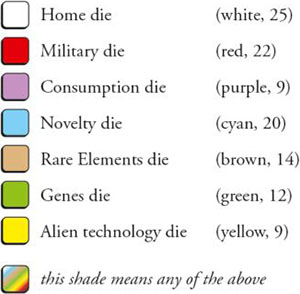
Setup
-
Put in Center of Play Area:

Use 12 VPs per player (in 1VP and 5VP chips):
Players VPs 2 24 3 36 4 48 5 60 Set the other 10 VP chips aside for use in the final round. Put the other VP chips away.
-
Give each player
- a dice cup
- a credit marker
- a mat
- a screen
- a phase strip
- initial tiles
Give one faction tile and one home world tile (each chosen at random) to each player. Return the rest to the box.
Each player puts these tiles face-up in front of his mat; these form the player's initial empire, represented by a tableau of tiles.
-
Each Player Draws Game Tiles:
Draw two tiles from the bag and place them in the construction zone on the mat. Put one tile development-side-up
 on the left and one tile world-side-up
on the left and one tile world-side-up  on the right.
on the right.For your first game, place these double-sided tiles so that the lowest-cost development and the lowest-cost world are face up. In later games, choose which of the two different ways you want to place your tiles.
-
Each Player Takes Dice:
- Put 3 Home (white) dice in your cup (
 ).
). - Put 2 Home dice in your Citizenry (
 ).
). - Take all dice granted by worlds (
 ) in your empire. Put them, as indicated, in the Citizenry (
) in your empire. Put them, as indicated, in the Citizenry ( ), the dice cup (
), the dice cup ( ), or as a good (
), or as a good ( ) placed on that world.
) placed on that world.
Do not take dice for the world in your construction zone; it will grant dice only when it is settled and moved into your tableau.

Fine Points
Dice from your faction and home world are taken only during Setup.
The home world Doomed World grants no dice; instead, its player starts with 8 Galactic Credits.
The faction Destroyed Colony has two worlds; both of them grant dice.
- Put 3 Home (white) dice in your cup (
Game Play
Roll for the Galaxy is played in rounds (usually 11-14). Each round consists of 5 steps:
- Roll
- Assign
- Reveal
- Do Phases - resolve the selected phases in order
- Manage Empire
Each step is done simultaneously by all players.
Repeat rounds until one or both game end conditions are met: all initial VP chips have been earned, or at least one player has 12 or more tile squares in his tableau. Finish that round and then total each player's VPs.
Roll
Players simultaneously roll all workers (dice in their cups) behind their screens.
Assign
Initially, assign workers to phases by placing them below the phase strip in columns, matching each die face rolled with the phase symbol.
In these rules and the tiles' power icons,  refers to any worker assigned to a phase.
refers to any worker assigned to a phase.
All  faces are wild. These workers can be assigned to any phase (multiple wild dice can go under the same or different columns).
faces are wild. These workers can be assigned to any phase (multiple wild dice can go under the same or different columns).

 Phase Selection.
Phase Selection.
Each player selects a phase by taking one worker and placing it on any space on the phase strip. Only selected phases occur.

This assigns this worker to the selected phase. The player now ignores this die's face and instead treats it as if its face was the selected phase.
 Reassign.
Reassign.
Some Developments Have Powers That Allow A Player To Reassign Workers To Other Phases, Placing Those Dice In Other Columns Below The Phase Strip ( ).
).
All players have one "built-in" Reassign power, Dictate, shown on the phase strip.
To Dictate, place any worker to the right of the phase strip (the Dictate area) and then Reassign another worker to a different column. The worker in the Dictate area will be returned to the cup.

Each Reassign power can be used at most once per round. Many powers are optional, as indicated by "may" in their descriptions.
When all players are done assigning their workers and using any Reassign powers, proceed to the next step.
Players who do the phases at different speeds should pause at this point until all players are ready. Adopting a house rule to show when players are ready, such as turning dice cups a certain way, may be useful.
 Development with Reassign power |
Tip: Move a Reassigned worker to its new column without rotating it to show a new face. This makes it easier to "undo" a power's use before screens are lifted.
Reveal
Each player lifts his screen to reveal his assigned workers, announcing the phase he has selected. Flip the matching phase tile from its "@x.jpg" side to its black side.
2-Player Game: roll a spare Home (white) die. If the rolled face is a phase that wasn't selected by either player, flip that phase tile over as well. This phase will also occur this round.
Return to players' cups any workers assigned to "@x.jpg" phases and any workers next to the Dictate area.

Phases 
Simultaneously, players do all selected phases in numeric order. To do a phase, use all workers assigned to it, including any worker that selected it.
Do not perform any phase not selected this round.
-
Explorer

- scout for a new tile and, optionally, replace tiles in the construction zone (
 ) OR
) OR - stock to gain 2 Galactic Credits (
 )
)
- scout for a new tile and, optionally, replace tiles in the construction zone (
-
Developer

Develop the topmost development (
 ) on the construction zone stack (move a completed development into your tableau)
) on the construction zone stack (move a completed development into your tableau) -
Settler

Settle the topmost world (
 ) on the construction zone stack (move a completed world into your tableau)
) on the construction zone stack (move a completed world into your tableau) -
Producer

produce a good (
 ) on a non-gray world (
) on a non-gray world ( ) in your tableau.
) in your tableau.Shipper

- trade a good to gain 3-6 Galactic Credits (
 )
) - consume a good, earning 1-3 VP chips
- trade a good to gain 3-6 Galactic Credits (
A worker does a task, depending on which phase it is assigned to:
In each phase, all workers must be used (if possible). They are used one at a time and may be used in any order. For Explore and Ship, complete one worker's task before deciding which task the next worker will do.
As they complete tasks, return used workers to the Citizenry ( ).
).
During Manage Empire, Galactic Credits ( ) are spent to recruit dice from the Citizenry into the cup to become workers for the next round.
) are spent to recruit dice from the Citizenry into the cup to become workers for the next round.
Galactic Credits ( ) are gained in various phases. Powers use the $ symbol to indicate credits (e.g., "+$2"). Track credits on the mat by shifting the Galactic Credit marker. A player may never have more than $10 at a time; any excess credits are lost.
) are gained in various phases. Powers use the $ symbol to indicate credits (e.g., "+$2"). Track credits on the mat by shifting the Galactic Credit marker. A player may never have more than $10 at a time; any excess credits are lost.
If, after completing all possible tasks, a player has spare workers for a phase, return them to the cup.
Most developments have a power. Powers can affect a phase or how a worker does a task.

 Phase 1: Explore
Phase 1: Explore
Use each explorer to either Scout ( ) or Stock (
) or Stock ( ). Put it in the Citizenry (
). Put it in the Citizenry ( ) after using it.
) after using it.
 Scout
Scout
To Scout - after possibly abandoning some tiles from your construction zone - draw 1 or more tiles from the bag and examine them. Then, in any order, choose whether each tile will be a development ( ) or world (
) or world ( ) and put it under its construction zone stack.
) and put it under its construction zone stack.
Draw 1 more tile than the number of tiles abandoned.
You may simply draw 1 tile; you need not abandon tiles. If the bag ever runs out of tiles, see page 10, Fine Points: Explore.
Tiles can be abandoned from any position in your construction zone stacks. Put abandoned tiles under the Explore phase tile.
You may abandon tiles every time you Scout, including tiles that you drew in earlier Scout tasks (see diagram below).
At the end of the Explore phase, return all abandoned tiles to the bag.
During Explore, developers and settlers on construction zone stacks stay on top of their stacks, even if a stack is emptied due to abandoning tiles.
The rule that both construction zone stacks must have one tile applies only during setup, not during play.

 Stock
Stock
To Stock, add 2 Galactic Credits ( ) to your total.
) to your total.
 Example: 3 Consecutive Scout Tasks |
 Phase 2: Develop
Phase 2: Develop
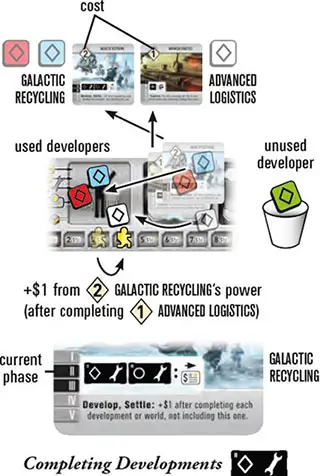
Put each developer, one at a time, on the top-most tile in the development construction zone ( ) stack.
) stack.
If the number of developers equals the top-most development's cost (the number in the  ), the development is complete. Move its tile to the tableau and put the developers who completed it in the Citizenry.
), the development is complete. Move its tile to the tableau and put the developers who completed it in the Citizenry.
Use any remaining developers to build the next tile in the stack. A player may complete more than one development in a Develop phase.
If any developers are left after completing all developments in the construction zone - the stack is empty - return them to the cup.
Occasionally, due to Explore powers or Scouting, the topmost development might be complete during an Explore phase. Do not move its tile to the tableau or return its developers until a Develop phase occurs. At the start of the next Develop phase, resolve completed developments, choosing which developers to return to the Citizenry.
Most developments grant a power once built, usable either during the Assign step, or in the phase(s) shown. Powers are mandatory, unless their text includes "may".
3 developments have "immediate effects" instead, similar to worlds.
 Phase 3: Settle
Phase 3: Settle
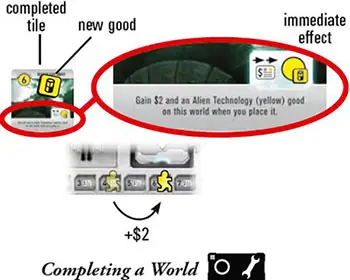
Put each settler, one at a time, on the top-most tile in the world construction zone ( ) stack.
) stack.
If the number of settlers equals the top-most world's cost (the number in the  ), the world is complete. Move its tile to the tableau and put the settlers who completed it in the Citizenry.
), the world is complete. Move its tile to the tableau and put the settlers who completed it in the Citizenry.
Use any remaining settlers to build the next tile in the stack. A player may complete more than one world in a Settle phase.
If any settlers are left after completing all worlds in the construction zone - the stack is empty - return them to the cup.
Occasionally, due to Explore powers or Scouting, the topmost world might be complete during an Explore phase. Do not move its tile to the tableau or return its settlers until a Settle phase occurs. At the start of the next Settle phase, resolve completed worlds, choosing which settlers to return to the Citizenry.
Each world has an immediate effect, shown on its tile. It occurs once, upon placing the tile. All worlds grant dice. Some worlds also give Galactic Credits. For immediate effects that involve removing one of your dice, return it from any location to the center.
Tip: To get more dice, settle more worlds. Avoid "locking up" too many workers trying to build expensive tiles.
 Phase 4: Produce
Phase 4: Produce
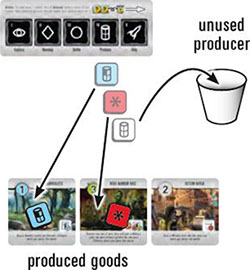
Each producer creates a good ( ) on a non-gray world (
) on a non-gray world ( ) in the player's tableau.
) in the player's tableau.
The producer die ( ) becomes the good; put it on the world.
) becomes the good; put it on the world.
Any producer die (of any color) can become a good on any non-gray world. Matching a good's color with the world's color matters only if the good will be Consumed, not if it will be Traded.
Each world can have at most 1 good (unless the player owns the Galactic Reserves development).
Return any excess producers to the cup.
 Phase 5: Ship
Phase 5: Ship
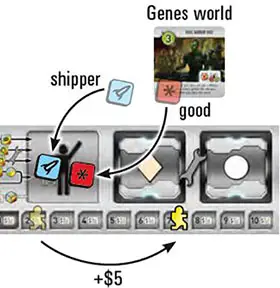
Each shipper takes a good ( ) horn a world in a player's tableau and either Trades (
) horn a world in a player's tableau and either Trades ( ) or Consumes (
) or Consumes ( ) it. Put both dice (the shipper and the good) in the Citizenry.
) it. Put both dice (the shipper and the good) in the Citizenry.
 Each Trade earns a player Galactic Credits (
Each Trade earns a player Galactic Credits ( ) according to the color of the good's world (not the color of the dice):
) according to the color of the good's world (not the color of the dice):
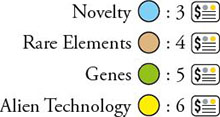
Some powers further increase these amounts.
Tip: Do early Trades to recruit more workers for future rounds.
 Each Consume earns the shipping player 1 to 3 VP chips:
Each Consume earns the shipping player 1 to 3 VP chips:
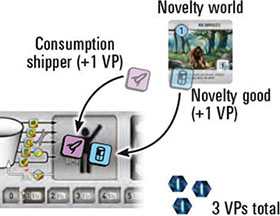
1 VP chip (always);
+1 VP chip if the good's color matches the world it is on;
+1 VP chip if the shipper's color matches the color of the good's world.
A Consumption (purple) die, used as either the good or the shipper, matches all colors and always earns +1 VP.
Using 2 Consumption dice, for both the good and the shipper, will always earn both VP bonuses.
Some powers further increase the number of VP chips earned or even earn the player Galactic Credits.
If the initial pool of VP chips runs out, add the set-aside 10 VP chips to the VP pool. Use them to continue earning VP chips for Consume tasks.
Emptying the initial pool of VP chips is one of two ways to trigger game end, ending the game after completing the entire round.
Tip: Use Consumption dice to gain extra VPs when you consume.
End of Phase
Return any excess shippers to the cup.
Manage Empire
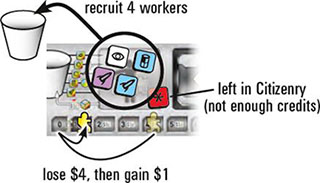
Recruit
Recruit workers by selecting dice from the Citizenry, putting them in your cup, and decreasing your Galactic Credits by 1 ( ) for each die recruited. Do this until either your Citizenry is empty or your credits run out. After recruiting, if your credits are at "0", shift the token to "1" (as shown on the player mat).
) for each die recruited. Do this until either your Citizenry is empty or your credits run out. After recruiting, if your credits are at "0", shift the token to "1" (as shown on the player mat).
If you have fewer credits than dice in Citizenry, you freely choose which dice to recruit.
Recall
You may recall any developers, settlers (from their construction zone stacks) and goods (from their worlds). Put them in your cup.
Recalling dice, unlike recruiting, does not cost Galactic Credits.
Tip: Recall dice when you have too many dice tied up in construction stacks or more goods than you expect to ship.
Reset
Flip all phase tiles to their "@x.jpg" sides.
Check Game End
If either the VP chip pool was exhausted or any player has 12 or more tile squares in his tableau (counting his double-sized faction tile as 2 tile squares), the game is over.
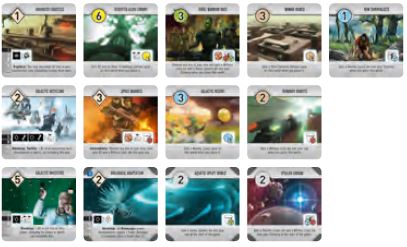 13 tile squares, triggering Game End |
End of the Game
Total each player's score:
VP chips.
VPs equal to the costs of all developments and worlds (the numbers in
 and
and  ). Do include both numbers from a faction tile. Do not include any tiles in the construction zone.
). Do include both numbers from a faction tile. Do not include any tiles in the construction zone.bonus VPs for 6-cost developments (beyond the 6 VPs for the development itself), as indicated on those tiles. When figuring these bonuses, round any fraction up to the next whole number.
The player with the most VPs wins!
If two or more players tie, each tied player adds:
- the number of dice in his cup.
- his Galactic Credits.
The player with the highest total among the tied players wins. If there is still a tie, all the tied players win.
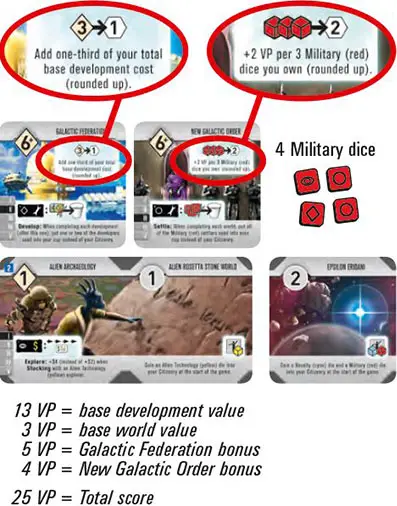
Timing
Most play can and should be done simultaneously. However, there are a few cases where player order can matter, such as:
- when a player might build to 12 or more tile squares (triggering game end), or
- when the VP chip pool might be exhausted (triggering game end).
When a need for strict timing occurs, do the phase in clockwise player order, starting with the player with the lowest numbered faction tile.
Etiquette
Which tiles are beneath the top tile of each construction zone stack are secret. A player may look at tiles in his own stacks at any time. When asked, he must tell other players the size of each stack.
Tiles abandoned during the Explore phase - under the Explore phase tile - are secret.
The only other secret information in the game is the workers rolled behind screens during a round's Roll and Assign steps.
As there is no way to verify players' actions behind screens, this game relies on players taking care to not make mistakes.
For Race For The Galaxy Players
Continue Reading
